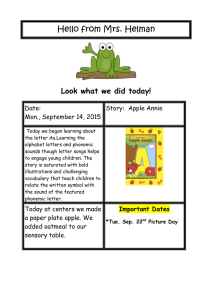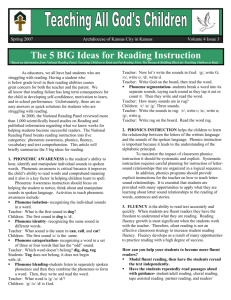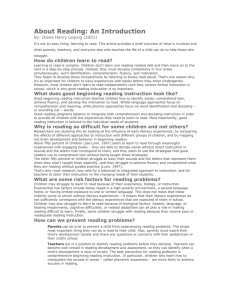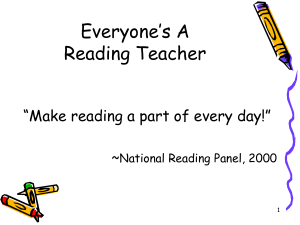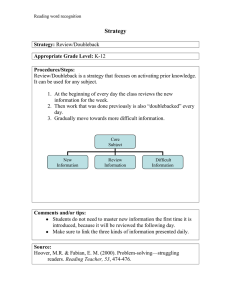Struggling Reader
advertisement
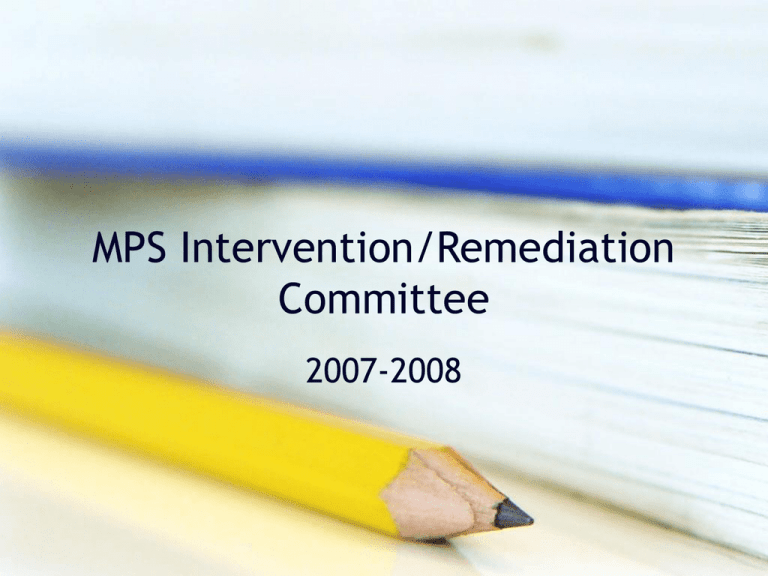
MPS Intervention/Remediation Committee 2007-2008 Intervention/Remediation • Why have an intervention/remediation committee? • Who is the committee composed of? • When will we meet? What will we discuss? The Struggling Reader: Interventions That Work • Remedial reading classes help students after the fact – they have already experienced failure • Legislation is demanding the we act sooner – No Child Left Behind/Reading First – Reading Sufficiency Act – 100% by 7/1/08 – Response to Intervention – IDEA 2004 The Struggling Reader: Interventions That Work • Response to Intervention – Response to Intervention aims to prevent unnecessary assignment to special education. With RTI, low-performing children are offered intense, individualized academic intervention. Student progress is monitored to see if response to this intervention yields adequate academic growth. The Struggling Reader: Interventions That Work • How do we respond to these high expectations? – We must take steps to prevent reading problems by intervening as soon as we identify a problem. The Struggling Reader: Interventions That Work • Successful interventions always increase the intensity of instruction – Torgesen, FCRR http://www.fcrr.org/newsletter/InterventionNews.pdf – Key is Positive Instructional Interactions (Pii) through: • Intensity – increased time • Focus – small group • Quality – research proven strategies & highly qualified teachers Chapter 1 – A PreventionIntervention Framework • A struggling reader is a student who is experiencing significant difficulty learning to read. (p. 10) • We can identify potential struggling readers before problems . . . Develop, and intervene if problems are already present (Snow, Burns, & Griffin, 1998). (p. 12) Chapter 1 – A PreventionIntervention Framework • Definitions – Remediation is the process of correcting a deficiency. Remediation is a term previously used to describe instruction given to struggling readers, suggesting that teachers should wait until a student is already failing & then correct problems. – Intervention is the process of coming into or between so as to hinder or alter an action. It involves providing instruction to struggling readers to stop further failure & help them make adequate yearly progress. – Prevention is the process of keeping something from happening. It involves identifying potential struggling readers & providing appropriate instruction so that failure is avoided. (pp. 12 -13) Chapter 1 – A PreventionIntervention Framework Cooper, Chard, and Kiger’s Framework 1. Assess and Diagnose 2. Teach/ Reteach 3. Practice 5. reassess 4. Apply Chapter 1 – A PreventionIntervention Framework The authors apply this framework to: • Oral language • Phonemic Awareness • Word Recognition • • • • Meaning Vocabulary Reading Fluency Comprehension Writing Chapter 2 – Oral Language • Components of Oral Language – Form – sounds, prosody, morphology, & syntax (sentence structure) – Content - vocabulary – Function – pragmatics (way a speaker communicates, purpose) Talk enhances the development of literacy. It is not a subject, but rather a condition of learning in all subjects. – David Booth Chapter 2 – Oral Language • Activities to Support Oral Language – – – – – – – Talk Read Aloud Dramatic Play Puppets Poems and Songs Word Play Elaborate Sentences Talk enhances the development of literacy. It is not a subject, but rather a condition of learning in all subjects. – David Booth Chapter 3 – Phonemic Awareness • Phonological Awareness – awareness of sounds in a language: syllables, onsets and rimes, or individual phonemes Segmenting Blending Deleting Words Phonological Awareness Substituting Syllables Rhymes Sounds Chapter 3 – Phonemic Awareness • Phonemic Awareness is one component of phonological awareness. • It is the understanding that words consist of individual sounds and being able to manipulate those sounds. • Phonemic awareness is an important skill for reading and writing. • It focuses on the oral aspect of sounds in words, not letters. Chapter 3 – Phonemic Awareness Sequence of activities • Sentences words segment & blend • Compound words separate words segment & blend • 2 syllable words – segment & blend • Multisyllabic words – segment & blend • Words onsets & rimes- segment & blend • Words phonemes segment & blend Chapter 3 – Phonemic Awareness IMPORTANT - Don’t delay phonics instruction for students who have not yet acquired phonemic awareness. Teaching letter-sound correspondences along with phonemic awareness gives students opportunities to develop in both areas. (Perfetti, Beck, Bell, & Hughes, 1987) Chapter 4 – Word Recognition • Word recognition – the ability to read words • Word recognition must be taught. • Word recognition requires applying a reliable, step-by-step strategy Chapter 4 – Word Recognition • • • • 4 Prerequisites Recognize the purposes of print Recognize the letters of the alphabet Understand that print represents speech Acquire phonemic awareness Chapter 4 – Word Recognition 1. 2. 3. 4. 5. 5 Elements of Systematic Word Recognition Instruction Letter-Sound Relationships Regular-Word Recognition Irregular-Word Recognition Advanced Word Recognition Story Reading Chapter 4 – Word Recognition • • • • Letter-Sound Relationships Teach more useful letter-sound relationships first Separate letter-sound relationships that are potentially confusing Teach continuous sounds before stop sounds Pace letter-sound instruction based on student success Chapter 4 – Word Recognition Regular-Word Recognition • Step 1 – Sound out the word • Step 2 – Say the word quickly • Step 3 – Sound out the word in your head before reading it aloud Chapter 4 – Word Recognition • Teach the most common, useful words first – Dolch, Fry • Monitor for success – 3 to 5 new words at a time • Frequent opportunities to practice – about 10 words at a time • Teach about 5 minutes/day before introducing in text Chapter 4 – Word Recognition Advanced Word Recognition “Larger Chunks” • Blends • Letter Combinations – consonant digraphs, vowel digraphs, diphthongs, & r-controlled vowels • Vowel-Consonant-e Patterns • Affixes Chapter 4 – Word Recognition • • • • Story Reading Decodable books Reread familiar books Encourage students to sound out in their head Gradually increase difficulty of texts Chapter 5 – Meaning Vocabulary How do students acquire meaning vocabulary? • Through wide reading, discussions, and life experiences • By developing an awareness of words – activities and games that require thinking about words • Through direct instruction • By learning vocabulary related skills – affixes, roots, contractions, compounds Chapter 5 – Meaning Vocabulary How do we help struggling readers develop meaning vocabulary? • Build an ongoing, daily awareness of words • Apply the intervention framework to meaning vocabulary • Provide vocabulary follow-up activities after reading Chapter 5 – Meaning Vocabulary How to build ongoing, daily awareness • • • • • Bulletin Boards Word Banks and Word Books Wide Reading – provide time to talk about books Read Aloud Daily Discussion of Words Chapter 5 – Meaning Vocabulary Teach key concept vocabulary before reading using the intervention framework • Select 6-8 words related to the key concepts in the text • Make sure the words are going to be useful in reading other texts • Know the context in which the words appear • Provide interactive instruction that builds connections for students • Use graphic representations during instruction Chapter 5 – Meaning Vocabulary Teaching vocabulary-related strategies and skills – 5 Step Strategy 1. 2. 3. 4. 5. I try to pronounce it using phonics. If I figure it out, I try reading the text aloud. Does it make sense? If not, I go to #3. I look for parts I know: prefixes, suffixes, base words, and root words. I think about their meanings. I read to the end of the sentence or paragraph trying the meanings. Does it make sense? If I still don’t know the word, I ask someone or look it up. Chapter 5 – Meaning Vocabulary After Reading – Providing Vocabulary Follow-Up Activities • • • • Synonyms Semantic feature analysis List-group-label Word sorts Chapter 6 – Reading Fluency What Is Reading Fluency? • According the National Reading Panel (2000), fluency is the ability to read text with speed, accuracy and proper expression. • Fluent readers: – – – – Recognize words automatically Read aloud effortlessly and with expression Do not have to concentrate on decoding Can focus on comprehension Chapter 6 – Reading Fluency Why Is Fluency Important? • It is a bridge between decoding and comprehension. • It increases motivation to read. Chapter 6 – Reading Fluency Fluency Strategies • • • • • • • Modeled reading - while student follow along Books on tape or computer – students follows along Word blending – 5 to 7 words Word-list reading – words with similar spelling patterns Repeated reading – independent level Coached reading (choral, whisper) – instructional level Wide reading Chapter 6 – Reading Fluency

